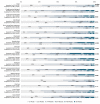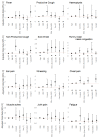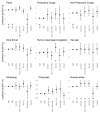Characterizing Risk Factors for Hospitalization and Clinical Characteristics in a Cohort of COVID-19 Patients Enrolled in the GENCOV Study
- PMID: 37632107
- PMCID: PMC10457914
- DOI: 10.3390/v15081764
Characterizing Risk Factors for Hospitalization and Clinical Characteristics in a Cohort of COVID-19 Patients Enrolled in the GENCOV Study
Abstract
The GENCOV study aims to identify patient factors which affect COVID-19 severity and outcomes. Here, we aimed to evaluate patient characteristics, acute symptoms and their persistence, and associations with hospitalization. Participants were recruited at hospital sites across the Greater Toronto Area in Ontario, Canada. Patient-reported demographics, medical history, and COVID-19 symptoms and complications were collected through an intake survey. Regression analyses were performed to identify associations with outcomes including hospitalization and COVID-19 symptoms. In total, 966 responses were obtained from 1106 eligible participants (87% response rate) between November 2020 and May 2022. Increasing continuous age (aOR: 1.05 [95%CI: 1.01-1.08]) and BMI (aOR: 1.17 [95%CI: 1.10-1.24]), non-White/European ethnicity (aOR: 2.72 [95%CI: 1.22-6.05]), hypertension (aOR: 2.78 [95%CI: 1.22-6.34]), and infection by viral variants (aOR: 5.43 [95%CI: 1.45-20.34]) were identified as risk factors for hospitalization. Several symptoms including shortness of breath and fever were found to be more common among inpatients and tended to persist for longer durations following acute illness. Sex, age, ethnicity, BMI, vaccination status, viral strain, and underlying health conditions were associated with developing and having persistent symptoms. By improving our understanding of risk factors for severe COVID-19, our findings may guide COVID-19 patient management strategies by enabling more efficient clinical decision making.
Keywords: COVID-19; SARS-CoV-2; clinical characteristics; comorbidities; hospitalization; risk factors; symptoms.
Conflict of interest statement
The authors declare no potential conflicts of interest with respect to the research, authorship, and/or publication of this article.
Figures







Similar articles
-
Clinical manifestations and disease severity of SARS-CoV-2 infection among infants in Canada.PLoS One. 2022 Aug 24;17(8):e0272648. doi: 10.1371/journal.pone.0272648. eCollection 2022. PLoS One. 2022. PMID: 36001553 Free PMC article.
-
Virtualized clinical studies to assess the natural history and impact of gut microbiome modulation in non-hospitalized patients with mild to moderate COVID-19 a randomized, open-label, prospective study with a parallel group study evaluating the physiologic effects of KB109 on gut microbiota structure and function: a structured summary of a study protocol for a randomized controlled study.Trials. 2021 Apr 2;22(1):245. doi: 10.1186/s13063-021-05157-0. Trials. 2021. PMID: 33810796 Free PMC article.
-
Persistent COVID-19 Symptoms at 6 Months After Onset and the Role of Vaccination Before or After SARS-CoV-2 Infection.JAMA Netw Open. 2023 Jan 3;6(1):e2251360. doi: 10.1001/jamanetworkopen.2022.51360. JAMA Netw Open. 2023. PMID: 36652247 Free PMC article.
-
Persistent COVID-19 symptoms are highly prevalent 6 months after hospitalization: results from a large prospective cohort.Clin Microbiol Infect. 2021 Jul;27(7):1041.e1-1041.e4. doi: 10.1016/j.cmi.2021.03.012. Epub 2021 May 10. Clin Microbiol Infect. 2021. PMID: 34125067 Free PMC article.
-
Factors Associated With Severe COVID-19 Among Vaccinated Adults Treated in US Veterans Affairs Hospitals.JAMA Netw Open. 2022 Oct 3;5(10):e2240037. doi: 10.1001/jamanetworkopen.2022.40037. JAMA Netw Open. 2022. PMID: 36264571 Free PMC article.
Cited by
-
Exploring lymphocyte subsets in COVID-19 patients: insights from a tertiary academic medical center with a high proportion of patients on immunosuppression.Front Immunol. 2024 Dec 3;15:1436637. doi: 10.3389/fimmu.2024.1436637. eCollection 2024. Front Immunol. 2024. PMID: 39691720 Free PMC article.
-
Syncopes, paresis and loss of vision after COVID-19 mRNA-based vaccination and SARS-CoV-2 infection.Infection. 2025 Apr;53(2):741-746. doi: 10.1007/s15010-024-02439-y. Epub 2024 Dec 2. Infection. 2025. PMID: 39621236 Free PMC article.
-
Public Health and Economic Impact of Periodic COVID-19 Vaccination with BNT162b2 for Old Adults and High-Risk Patients in an Illustrative Prefecture of Japan: A Budget Impact Analysis.Infect Dis Ther. 2024 Oct;13(10):2155-2177. doi: 10.1007/s40121-024-01032-y. Epub 2024 Sep 10. Infect Dis Ther. 2024. PMID: 39254889 Free PMC article.
References
-
- Docherty A.B., Harrison E.M., Green C.A., Hardwick H.E., Pius R., Norman L., Holden K.A., Read J.M., Dondelinger F., Carson G., et al. Features of 20 133 UK Patients in Hospital with COVID-19 Using the ISARIC WHO Clinical Characterisation Protocol: Prospective Observational Cohort Study. BMJ. 2020;369:m1985. doi: 10.1136/bmj.m1985. - DOI - PMC - PubMed
Publication types
MeSH terms
Grants and funding
LinkOut - more resources
Full Text Sources
Medical
Miscellaneous

